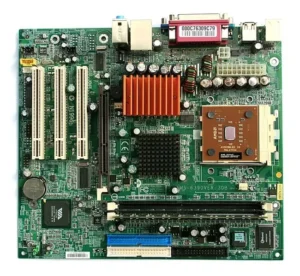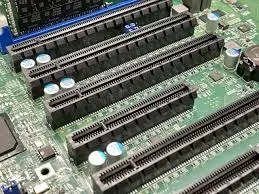Exploring the Significance of PCI in Computers: Understanding the Full Form and its Importance
If you’ve ever opened up a desktop computer and taken a look inside, you’ve likely noticed the various Expansion cards and slots that make up its internal components. One of the most common types of slots is the PCI slot, short for Peripheral Component Interconnect. But what exactly does PCI stand for, and why is it so important in modern computing systems? This blog post will explore the full form of PCI and examine why this connection standard has become a staple in computers over the past few decades.
What is PCI?
PCI is an interface standard used to connect peripheral devices to a computer’s motherboard. The PCI slots on the motherboard provide expansion capabilities by allowing you to insert PCI cards, which add functionality to your computer system.

Some common examples of PCI cards include:
- Graphics cards
- Sound cards
- Network cards
- Storage controller cards
Without PCI, you’d be limited to only the ports and devices built directly into the motherboard. But PCI provides an avenue to customize and enhance your system by adding new hardware through plugin cards.
The Definition and Purpose of PCI
So what does the acronym PCI actually stand for? PCI stands for Peripheral Component Interconnect.
The PCI specification defines a standard for connecting and communicating between peripheral devices and the motherboard. This provides an interface with certain guaranteed capabilities that device manufacturers can rely on for compatibility.
The goals and purpose behind PCI technology include:
- Allowing for peripheral expansions cards to be added easily to a system
- Providing plug and play capabilities
- Maintaining high performance for data transfer between components
- Ensuring forward and backward compatibility between devices and systems
With these aims in mind, PCI was designed as an improvement over earlier expansion bus standards like ISA and EISA in terms of performance, flexibility, and cost-effectiveness.
Evolution and Versions of PCI
The PCI bus standard has continued to evolve over the years to provide even greater capabilities:

- PCI
The original PCI 1.0 specification was introduced in 1992. It provided a 32-bit data bus transferring at 33 MHz, giving a throughput of 133 MB/s. This was a major increase compared to earlier standards. - PCI 2.0
An update in 1993 doubled the clock speed to 66 MHz. This allowed maximum throughput of up to 528 MB/s. - PCI-X
In the late 90s, PCI-X 1.0 arrived offering speeds up to 133 MHz and a 64-bit bus, increasing theoretical maximum throughput to over 1 GB/s. Further revisions pushed speeds ever higher. - PCI Express
In 2004, PCI Express (PCIe) debuted as a major evolution in PCI technology. PCIe uses high-speed serial links rather than a shared parallel bus, providing even higher theoretical bandwidth. It also introduced innovations like hot-swap support. Modern computers now primarily utilize PCI Express, which continues to be updated to faster generations like PCIe 4.0 and PCIe 5.0. This demonstrates the lasting impact PCI has had in the computing world.
Advantages of PCI
As mentioned above, PCI brought about major improvements over earlier expansion buses. Some specific advantages of PCI include:
- Versatility and Expandability
A major selling point of PCI is its versatility in allowing varied peripheral devices to be added to a computer via expansion cards. This provides practically unlimited options for customization and upgrading. - Increased Bandwidth
PCI offered substantial leaps forward in potential bandwidth and data transfer speeds compared to earlier standards. This has continued improving with each new generation. - Compatibility
PCI slots are designed to be backward compatible. So PCI cards will work in newer PCIe slots. There is also forward compatibility in that new cards often still work in older systems. - Hot Swapping
PCI Express allows devices to be added or removed without shutting down the system first. This hot swapping makes upgrading or replacing components quick and seamless.
Understanding Different Types of PCI Slots
There are a few common varieties of PCI slots that you’ll see on motherboards and expansion cards. The type of slot matches up with the connector on the card itself. Here’s a breakdown of the different PCI slots and their general functions:
PCI Slots and Their Functions
1. PCI
The original PCI slots (often called PCI parallel) have a 32-bit connector typically colored white. They transfer data at up to 133 MB/s and are outdated at this point, but still work with many modern cards.
2. CI-X
PCI-X slots use a 64-bit connector and support faster speeds ranging from 266 MB/s up to 1 GB/s depending on the version. They have been superseded by PCIe but some older motherboards included support for backward compatibility.
3. PCIe: sizes PCIe x1, PCIe x4, PCIe x8, and PCIe x16.
These slots are used for graphics cards, high-speed storage devices (such as solid-state drives), and other high-performance peripherals. They feature a recognizable design with one to sixteen parallel lanes. Bandwidth scales with the number of lanes. Common configurations include:
- PCIe x1 (1 lane, 1 GB/s) – Often used for simple controllers.
- PCIe x4 (4 lanes, 4 GB/s) – Supporting fast SSDs and RAID controllers.
- PCIe x8 (8 lanes, 8 GB/s) – High-end SSDs and network cards.
- PCIe x16 (16 lanes, 16 GB/s) – Primarily graphics cards.
Newer PCIe generations boost the per-lane performance. So a PCIe 4.0 x16 slot can transfer up to 64 GB/s total.
The Future of PCI
Even after 30 years, PCI remains the dominant interface for expansion cards and high-speed peripherals. But new technologies are emerging that may complement or even succeed PCI Express in the future.
Emerging Interconnects
As bandwidth demands continue growing, new interconnect technologies are being developed to keep pace. Some examples include:
- CXL (Compute Express Link) – An open standard in development optimizing connections for devices like accelerators and memory expansions.
- CCIX (Cache Coherent Interconnect for Accelerators) – Enables cache coherency between CPUs and accelerators. Helpful for workflows using GPUs and FPGAs.
- Gen-Z – A high-speed, memory-semantic protocol designed to unify and enhance system connectivity.
PCI Express Gen 4 and 5
While new interconnects are appearing, PCI Express continues evolving as well. PCIe 5.0 doubles throughput speeds again, pushing up to 64 GB/s with x16 lanes. Some cutting-edge systems already support PCIe Gen 4, and adoption of Gen 5 will ramp up over the next few years.
Learn more about PCI Full form in Computer, visit Acronym Founder.
Conclusion
After examining the PCI full form in computer meaning along with its various versions and capabilities, it’s clear why this standard has become so prolific. PCI transformed computer expandability starting in the 90s, providing substantial improvements in performance, compatibility, and ease of use. Now firmly entrenched as the primary motherboard interface, PCI will continue advancing to meet demands for bandwidth and connectivity. While emerging standards may complement it someday, PCI Express remains the go-to solution for everything from gaming pc gor gta 5 graphics to business storage networks. The next time you crack open a desktop tower or laptop, take a moment to appreciate the PCI slots and all the capabilities they unlock!
| If you are reading PCI full form in computer then also check our other blogs: | |
| Desktop without CPU | Father of Personal computer |
| Storage device | SSD for Desktop |
| Hard disk Drive | Types of Cooling |
pci full form computer
- What are the different types of PCI slots?The main PCI slot varieties are the original PCI parallel slots, PCI-X slots, and the current PCI Express (PCIe) slots. PCIe comes in sizes from x1 up to x16 based on the number of data lanes. Smaller PCIe slots are often used for simple controllers while larger ones are ideal for graphics cards and other bandwidth-hungry devices.
- Can I upgrade my computer's PCI slots?Unfortunately the PCI slots built into your computer's motherboard cannot be directly upgraded or changed. However, you can install newer/faster PCI cards into older PCI slots to improve performance. Just ensure there is backward compatibility. For example, PCIe 3.0 graphics cards will work in a PCIe 2.0 slot.
- What does PCI stand for?PCI stands for Peripheral Component Interconnect. It is the standard interface used for connecting expansion cards and other devices to a computer's motherboard.
- What is the purpose of PCI in computers?The PCI interface provides an avenue for enhancing a computer's capabilities through expansion cards. It allows users to customize their system by adding new hardware such as graphics cards, network adapters, sound cards, and storage controllers. PCI offers plug and play simplicity and provides substantial improvements in bandwidth over earlier standards.
- Toggle TitleToggle Content
